Table of Contents
The UK has only six native species of reptiles, not all of which can be found along the British Coastline. However, some lizard species prefer coastal habitats, including sand dunes. Additionally, amphibians such as toads can be found in areas such as the Solway Coast in Scotland. Leatherback Turtles are also increasingly visible off the British Coastline!
Lizards
Sand Lizard
The sand lizard is a small lizard species, averaging 20 cm in length. Females are sandy brown with dark blotches along their backs, while males are bright green with dark speckles.
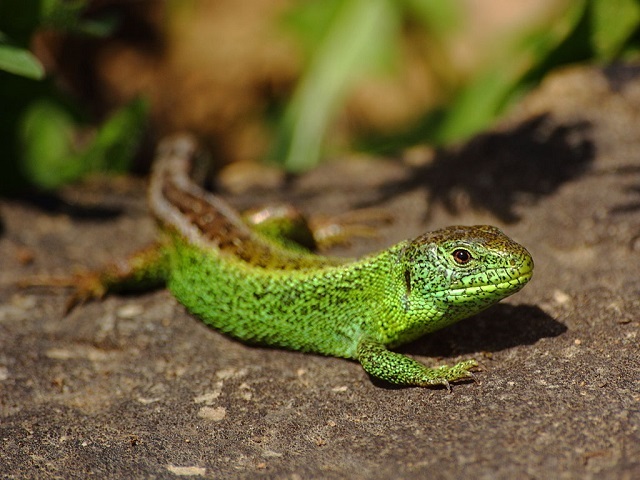
© Christoph Caina / Wikimedia Commons
| Latin Name | Lacerta agilis |
| Diet | Feeds on a range of foods, including insects, fruits and slugs. |
| Best time to see | May to August. |
| Distribution | Sand lizards occur patchily in southern England, north-west England and Wales. |
| Habitat | Lowland heaths and coastal sand dunes are preferred, especially in south-facing areas. |
| Reproductive Mode | Oviparity – Egg-laying. |
| Interesting fact | Sand lizards can shed their tails if they are attacked by predators, a process known as autotomy. This tactic distracts the aggressor, often helping the lizards to escape being eaten. |
Slow Worm
The slow worm is a species of legless lizard that can be identified by its snake-like appearance and smooth, grey skin. Males are usually paler than females, and the average adult length is 45 cm.
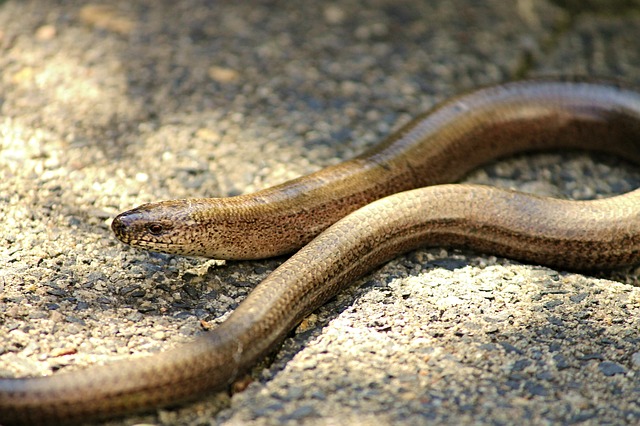 Photo: Manfred Richter
Photo: Manfred Richter
| Latin Name | Anguis fragilis |
| Diet | A carnivorous species, largely feeding on slugs and worms. |
| Best time to see | April to August. |
| Distribution | Slow worms are found throughout the UK, with the exception of Northern Ireland and some Scottish islands. |
| Habitat | Often seen in grassland, heathland and wooded areas, especially in warm areas. |
| Reproductive Mode | Ovoviviparity – Eggs develop within the female and emerge as live young. |
| Interesting fact | The slow worm gets its name from its burrowing behaviour, and can often be found hiding underneath objects and hunting among warm compost heaps. |
Viviparous Lizard
Viviparous lizards measure 13 cm in length on average and are generally brownish-grey in colour, with dark markings. Males have bright orange undersides.
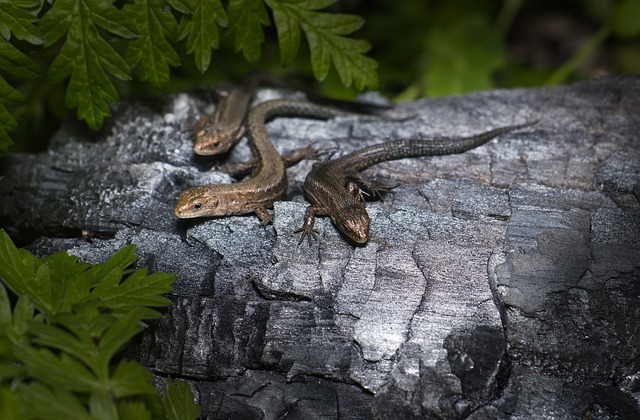
Photo: Erik Karits
| Latin Name | Zootoca vivipara |
| Diet | Mainly feeds on worms, slugs and other small invertebrates. |
| Best time to see | May to July. |
| Distribution | Viviparous lizards are widespread in the UK, found almost everywhere apart from a few offshore islands. |
| Habitat | Sunny, dry habitats such as grassland and heathland are the best places to find this species. |
| Reproductive Mode | Viviparity – Live young-bearing. |
| Interesting fact | In more northerly regions, the viviparous lizard hibernates over winter in a log pile or underground burrow, emerging again when the weather warms in mid-February. |
Snakes
Adder
The adder is a striking species of snake, easily identifiable by its zig-zag markings down its back. Males are grey with black markings, while females are brown. Their average length is 70 cm.

Photo: Erik Karits
| Latin Name | Vipera berus |
| Diet | Hunts for small mammals, lizards and ground-nesting birds. |
| Best time to see | May to August. |
| Distribution | Adders can be found in many parts of the UK, but are not present in Northern Ireland or some offshore islands. |
| Habitat | Lives in a variety of habitats, including coastal grassland, wooded areas and heath. |
| Reproductive Mode | Eggs develop within the female and emerge as live young. |
| Interesting fact | The adder is the only venomous snake found in the UK. It is not a great threat to humans however, as its venom is mild and the species prefers to avoid people where possible. |
Barred Grass Snake
Barred grass snakes are the longest snakes in the UK, measuring 1.2 m on average. They are generally dark green in colour, with black barring and a black and yellow collar.
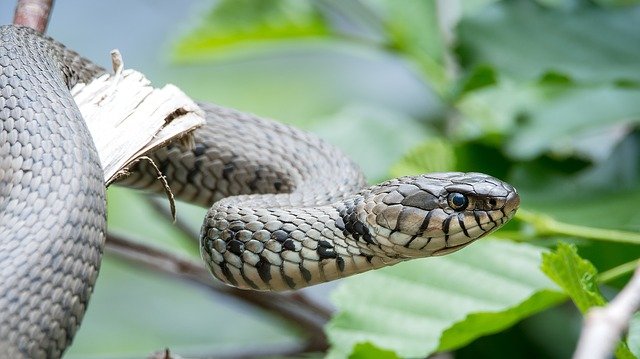
Photo: winterseitler
| Latin Name | Natrix helvetica |
| Diet | Amphibians such as frogs and toads are eaten most often, supplemented by insects. |
| Best time to see | May to August. |
| Distribution | Barred grass snakes are widespread in England and Wales, but are absent elsewhere. |
| Habitat | Mainly found near freshwater, in habitats such as woodland, heath and grassland. |
| Reproductive Mode | Oviparity – Egg-laying. |
| Interesting fact | When threatened, barred grass snakes will ‘play dead’ and release a foul-smelling substance from their anal glands, behaviour which often puts potential predators off. |
Smooth Snake
The smooth snake is generally brown or grey in colour, with a dark crown on the head. It has a slender body and measures 60 cm in length.
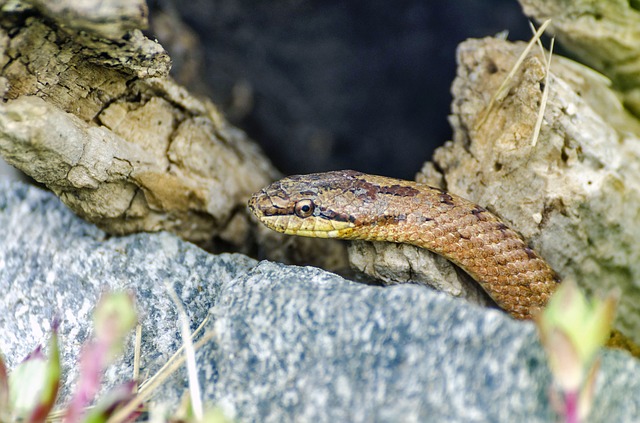
Photo: Onkel Ramirez
| Latin Name | Coronella austriaca |
| Diet | Feeds mainly on small mammals and lizards, although birds will also be eaten. |
| Best time to see | April to October. |
| Distribution | Smooth snakes are restricted to a few areas of southern England, such as Dorset and Hampshire. |
| Habitat | Found primarily in coastal heathland habitats, particularly in sunny areas. |
| Reproductive Mode | Ovoviviparity – Eggs develop within the female and emerge as live young. |
| Interesting fact | The smooth snake is harmless to humans, but subdues its prey by coiling around its body and crushing it to death. |
Turtles
Leatherback Sea Turtle
The leatherback sea turtle is a very large species, reaching an average length of 2 m. It lacks an obvious shell – instead having a leathery back – and is generally black in colour, with white dots all over the body.
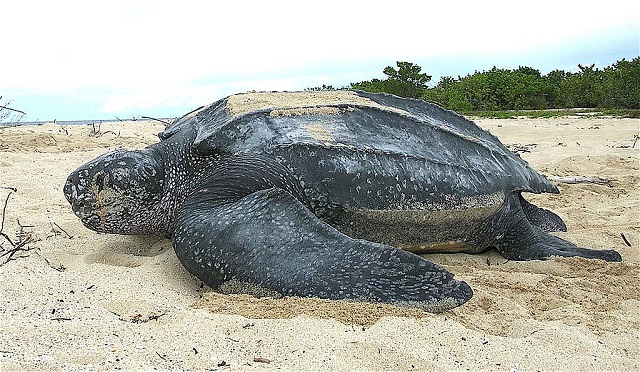
Photo: U.S. Fish and Wildlife Service Southeast Region, Public domain, via Wikimedia Commons
| Latin Name | Dermochelys coriacea |
| Diet | Almost entirely jellyfish. |
| Best time to see | June to August. |
| Distribution | Leatherback sea turtles are largely found on western coasts of the UK, especially in the south of England. |
| Habitat | Spends most of its time in open ocean, sometimes coming close to shore in order to feed. |
| Reproductive Mode | Oviparity – Egg-laying. |
| Interesting fact | Leatherback sea turtles possess backwards-facing spines within their throats, ensuring that prey cannot escape after being captured. |
Frogs
Common Frog
The common frog is very variable in colour, coming in a range of greens, browns and yellows. It has a dark mask behind both eyes and measures 10 cm in length on average.
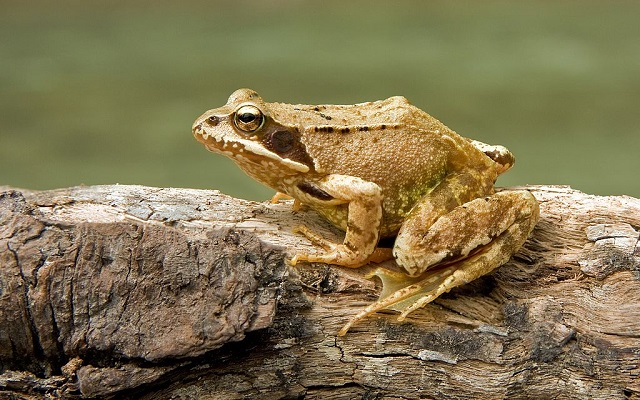
Photo: Richard Bartz, Munich aka Makro Freak Image:MFB.jpg, CC BY-SA 2.5, via Wikimedia Commons
| Latin Name | Rana temporaria |
| Diet | Feeds mainly on insects and other invertebrates. |
| Best time to see | April to July. |
| Distribution | Common frogs are found throughout the UK, apart from a few offshore islands. |
| Habitat | Freshwater habitats such as ponds and lakes are preferred, but terrestrial regions surrounding these areas will also be used. |
| Reproductive Mode | Oviparity – Egg-laying. |
| Interesting fact | Female common frogs can lay as many as 4,000 eggs in just one season. The tadpoles are herbivorous when young, but progress to a carnivorous diet of aquatic insects and larvae. |
Toads
Common Toad
Common toads have brownish, warty skin and short back legs. They usually measure 11 cm in length and have copper-coloured eyes.
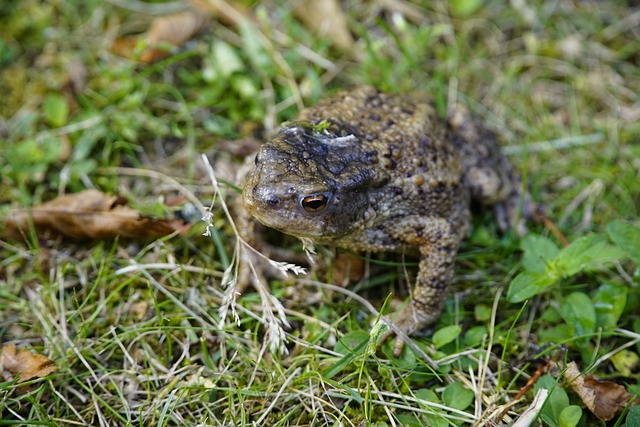
Photo: jhenning
| Latin Name | Bufo bufo |
| Diet | Feeds on invertebrates such as worms, slugs and woodlice, as well as the occasional small rodent. |
| Best time to see | March to July. |
| Distribution | Common toads are widespread in the UK, but are absent from Northern Ireland and some offshore islands. |
| Habitat | Mainly found in forested areas, as well as grasslands, gardens and farmland. |
| Reproductive Mode | Oviparity – Egg-laying. |
| Interesting fact | The first warm, damp evenings of the year often spur common toads to begin mass migrations to their breeding pools in order to find a mate. 80% return to the same pools where they were born. |
Natterjack Toad
The natterjack toad is a small toad species, measuring just 7 cm in length. It is olive-brown in colour, with a distinctive yellow stripe which runs down its back.

Christian Fischer, CC BY-SA 3.0, via Wikimedia Commons
| Latin Name | Epidalea calamita |
| Diet | Feeds mostly on insects, particularly beetles. |
| Best time to see | March to August. |
| Distribution | Natterjack toads are patchily distributed around the UK coast, with populations in south-east England, Wales and parts of Scotland. |
| Habitat | Coastal habitats such as sand dunes, marshes and heathland are favoured. |
| Reproductive Mode | Oviparity – Egg-laying. |
| Interesting fact | Natterjack toads are famous for their loud mating calls, which are produced by the vocal sacs of the males and can be heard more than 2 km away on quiet evenings. |
Newts
Great Crested Newt
As the largest newt in the UK, the great crested newt reaches an average length of 14 cm. Both sexes are black with orange bellies and warty skin, but males develop a striking crest during the breeding season that runs down the length of the body.

Photo: Rainer Theuer., Public domain, via Wikimedia Commons
| Latin Name | Triturus cristatus |
| Diet | Aquatic and terrestrial invertebrates, including woodlice, worms and tadpoles. |
| Best time to see | March to July. |
| Distribution | Great crested newts are widespread in England and Wales, but occur more sporadically in Scotland. |
| Habitat | Wooded areas and hedgerows are preferred for most of the year, with large ponds being the main habitat during the breeding season. |
| Reproductive Mode | Oviparity – Egg-laying. |
| Interesting fact | The pattern of black spots on a great crested newt’s belly is unique to the individual, meaning newts can be identified in a similar way to humans with fingerprints. |
Palmate Newt
The palmate newt is generally olive-brown in colour, with dark markings and an orange belly. It averages 8 cm in length, with males possessing smooth crests on their backs.
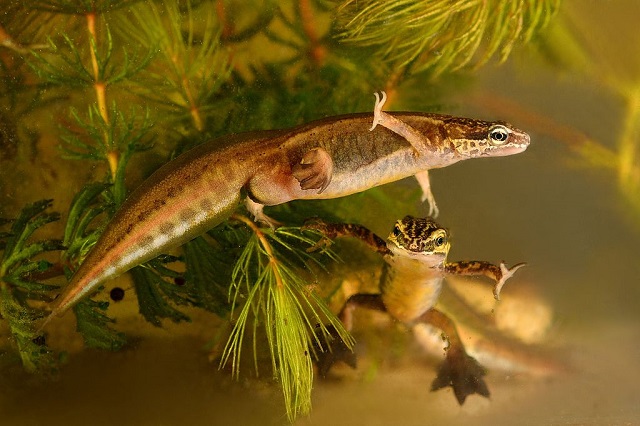
Photo: Gilles San Martin from Namur, Belgium, CC BY-SA 2.0, via Wikimedia Commons
| Latin Name | Lissotriton helveticus |
| Diet | Feeds largely on invertebrates such as worms and beetles. |
| Best time to see | April to August. |
| Distribution | Palmate newts are found across much of the UK, although are absent from Northern Ireland. |
| Habitat | Ponds in acidic habitats such as heathland and moorland are favoured. |
| Reproductive Mode | Oviparity – Egg-laying. |
| Interesting fact | Palmate newts hibernate during the winter months, often choosing underground burrows amongst tree roots to do so. They can live for up to 10 years. |
Smooth Newt
Smooth newts are brown in colour, with yellow or orange bellies and black spots. They average 8 cm in length, and males develop a wavy crest during the breeding season.
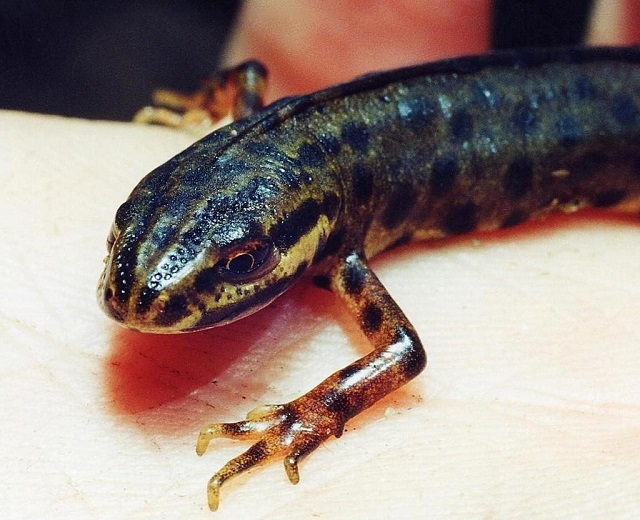
Photo: Christian Fischer, CC BY-SA 3.0, via Wikimedia Commons
| Latin Name | Lissotriton vulgaris |
| Diet | A wide range of invertebrates are eaten, both terrestrial and aquatic. |
| Best time to see | April to July. |
| Distribution | Smooth newts are found in many areas of the UK, but are absent from Northern Ireland and parts of south-west Scotland. |
| Habitat | Mainly seen in or around ponds, in habitats such as damp meadows, woodland and gardens. |
| Reproductive Mode | Oviparity – Egg-laying. |
| Interesting fact | Male smooth newts engage in an elaborate underwater courtship display to attract mates during the breeding season, often circling the females and vibrating their tails vigorously. |
References:
Amphibian & Reptile Conservation Trust – https://www.arc-trust.org/
Animal Diversity Web – https://animaldiversity.org/
Froglife – https://www.froglife.org/info-advice/amphibians-and-reptiles/
RSPB – https://www.rspb.org.uk/
Scottish Wildlife Trust – https://scottishwildlifetrust.org.uk/
The Wildlife Trusts – https://www.wildlifetrusts.org/
